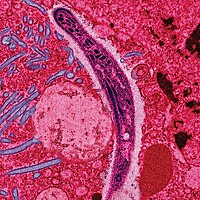
Factors influencing wind turbine avoidance behaviour of a migrating soaring bird
Sign Up to like & getrecommendations! Published in 2022 at "Scientific Reports"
DOI: 10.1038/s41598-022-10295-9
Abstract: Wind energy production has expanded as an alternative to carbon emitting fossil fuels, but is causing impacts on wildlife that need to be addressed. Soaring birds show concerning rates of collision with turbine rotor blades… read more here.
Keywords: wind turbines; avoidance behaviour; avoidance; wind ... See more keywords

Ranavirus infection-induced avoidance behaviour in wood frog juveniles: do amphibians socially distance?
Sign Up to like & getrecommendations! Published in 2022 at "Biology Letters"
DOI: 10.1098/rsbl.2022.0359
Abstract: Hosts may limit exposure to pathogens through changes in behaviour, such as avoiding infected individuals or contaminated areas. Here, we tested for a behavioural response to ranavirus infection in juvenile wood frogs (Rana sylvatica) because… read more here.
Keywords: infection induced; infection; induced avoidance; avoidance behaviour ... See more keywords

Reconciling Perspectives on Blame Avoidance Behaviour
Sign Up to like & getrecommendations! Published in 2017 at "Political Studies Review"
DOI: 10.1111/1478-9302.12099
Abstract: Blame avoidance behaviour (BAB) has become an increasingly popular topic in political science. However, the preconditions of BAB, its presence and consequences in various areas and in different political systems largely remain a black box.… read more here.
Keywords: blame avoidance; perspectives blame; avoidance behaviour; reconciling perspectives ... See more keywords

Avoidance behaviour modulates but does not condition phonophobia in migraine
Sign Up to like & getrecommendations! Published in 2022 at "Cephalalgia"
DOI: 10.1177/03331024221111772
Abstract: Background Past studies do not account for avoidance behaviour in migraine as a potential confounder of phonophobia. Objective To analyse whether phonophobia is partially driven by avoidance behaviour when using the classic methodology (method of… read more here.
Keywords: phonophobia; methodology; migraine; avoidance behaviour ... See more keywords

Modification of contact avoidance behaviour associated with pyrethroid resistance in Anopheles sinensis (Diptera: Culicidae)
Sign Up to like & getrecommendations! Published in 2019 at "Malaria Journal"
DOI: 10.1186/s12936-019-2765-3
Abstract: BackgroundAnopheles sinensis is the primary vector of vivax malaria in China and its control is under great threat as the development of insecticide resistance. In contrast to physiological resistance, there is no report of behavioural… read more here.
Keywords: deltamethrin; sinensis; resistance; avoidance behaviour ... See more keywords

Avoidance behaviour in laboratory house mice (Musmusculus) and Norway rats (Rattus norvegicus) towards predator odours
Sign Up to like & getrecommendations! Published in 2021 at "PLoS ONE"
DOI: 10.1371/journal.pone.0245441
Abstract: Mus musculus and Rattus sp. are considered pest species because they reach high densities in urban areas, crop fields and food storage and productive systems such as breeding farms and orchards. Their control relies mainly… read more here.
Keywords: rattus norvegicus; avoidance behaviour; cat; mice ... See more keywords

Avoidance Behaviour of Six Collembolan Species Shows Species-Specific Sensitivity—Impact of Ag NM300K
Sign Up to like & getrecommendations! Published in 2022 at "Nanomaterials"
DOI: 10.3390/nano12193276
Abstract: Although standard testing guidelines use a species as a representative surrogate, species-specific sensitivity is well-known. The aim of this study was to investigate the species-specific difference in avoidance behaviour among Collembola species exposed to silver… read more here.
Keywords: avoidance behaviour; specific sensitivity; species specific; avoidance ... See more keywords

Avoidance behaviour toxicity tests should account for animal gregariousness: a case study on the terrestrial isopod Porcellioscaber
Sign Up to like & getrecommendations! Published in 2022 at "ZooKeys"
DOI: 10.3897/zookeys.1101.76711
Abstract: Abstract Avoidance behaviour enables woodlice to escape suboptimal environmental conditions and to mitigate harmful effects of pollutants. However, several studies have shown that at least in some woodlice species the tendency to aggregate can lead… read more here.
Keywords: gregariousness; avoidance; avoidance behaviour; behaviour toxicity ... See more keywords